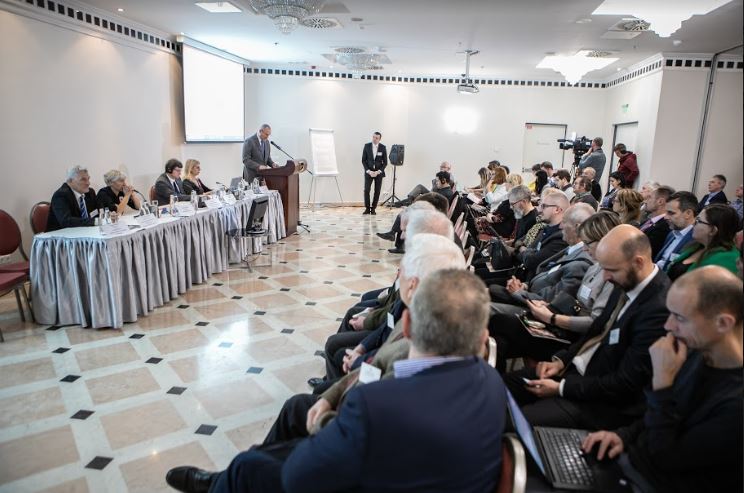The Association held its conference focusing on innovation and sustainability on 5 December 2019. Speakers and topics: “Hungarian confectionery industry from the point of view of the Ministry of Agriculture” – Róbert Zsigó, State Secretary for Food Chain Supervision of the Ministry of Agriculture; “Changing trends and consumer needs in the global confectionery market” – Sándor Sánta, President, Association of Hungarian Confectionery Manufacturers;
“Climate change: can it be stopped?” – Diána Ürge-Vorsatz, Vice Chair of Work Group III of the Intergovernmental Panel on Climate Change (IPCC); “Confectionary industry in the context of sustainability and diets” – Vladimir Rakhmanin, Assistant Director-General and Regional Representative for Europe and Central Asia, Food and Agriculture Organization of the United Nations (FAO); “The cost of our sweet life – The environmental impact of the confectionery industry and its possible reduction from the natural resources perspective “- Katalin Sipos, Country Director, World Wildlife Fund (WWF); „Increasing the biological value of confectionery products” – Dr. Ernő Gyimes PhD, Associate Professor, Institute of Food Engineering, Faculty of Engineering, University of Szeged;
“Innovation in packaging technology – packaging of the future” – Miklós Nagy, Secretary General, Hungarian Association for Packaging and Material Handling (CSAOSZ).
Presentation folder > click here.
Confectionery: Future, Innovation, Sustainability
Summary of the Hungarian Confectionery Manufacturers’ Conference
In his opening speech, Róbert Zsigó, State Secretary for Food Chain Supervision of the Ministry of Agriculture said that the efficiency of the Hungarian confectionery industry has increased spectacularly. With over 250 companies and close to 5,000 employees, the segment had a turnover of more than HUF 211 billion and profits in excess of more than HUF 9 billion last year. The foreign trade performance of the confectionery industry is similarly encouraging, with exports of chocolate products increasing by nearly EUR 30 million and imports by about EUR 60 million last year compared to the data of four years ago. The total turnover of the Hungarian food industry has also increased by almost 50% – from HUF 2,800 billion to about HUF 4,000 billion – since 2010, while the proportion of exports has been growing at a rate of over 30% for years. At the same time, the willingness to invest in the sector is increasing, thanks to growing subsidies, said the State Secretary; since 2014, more than HUF 300 billion has poured into the food industry from domestic and EU sources.
Sándor Sánta, President of the Association of Hungarian Confectionery Manufacturers, explained that it will be necessary to continue to support developments, because while the climate crisis threatens the world’s food supply, the supply of raw materials for the food industry and within it the confectionery industry as well, in parallel consumer demands and shopping habits are swiftly changing too. According to global surveys, one third of meals will be solved with pre-packaged food, and a quarter will be eaten at catering establishments, and the number of food delivery orders may increase by as much as 1000% in the next ten years. According to Mondelez’s recent report (State of Snacking), snacking is turning into a meal too: 70% of the Millennial Generation’s main meals are often preferred to be the consumption of substantial snacks. At the same time, consumers are not only looking for novelty, but they continue to insist on trusted, traditional brands and the delights of sweets. In addition to enjoyment, consumers appreciate food products that can be seamlessly incorporated into balanced or special diets, and the credibility, reliability and commitment of the manufacturer to sustainability are important considerations too. For these reasons, confectionery manufacturers need to find sustainable solutions that combine the best traditions and innovative responses to new challenges in order to maintain and strengthen their competitiveness. To meet these goals, the Association of Chocolate, Biscuit and Confectionery Industries of Europe, CAOBISCO, has launched the ‘treatwell’ initiative, in which the Hungarian association is also involved.
Diána Ürge-Vorsatz, Vice-President of the United Nations Intergovernmental Panel on Climate Change (UN IPCC) on Emissions Reduction, drew attention to the fact that climate change is causing extreme weather effects, the consequences of which can also be felt in agriculture. In Hungary, the warming by 1° Celsius has, for example, reduced the yields of four major cereals by 10-15%. If the trend continues, the Agricultural Economics Research Institute predicts that by the end of the century the yield of corn may decrease by up to 35% and that of wheat by 25%, while potatoes will not grow at all in Hungary in 30 years’ time. According to other forecasts, by then the climate in the equatorial zone may also become unsuitable for cocoa production, so by 2050 one of the particularly important raw materials for the production of confectionery may be completely eliminated due to climate change.
Katalin Sipos, a biologist and the Director of WWF Hungary, warned that animals, including pollinating insects, are losing their habitat due to global warming and the over-exploitation of production areas, which is also destroying the natural environment around them. According to the organization’s latest biodiversity report (2018 Living Planet Index), the wildlife population declined by more than 60% between 1970 and 2014, falling to less than half in just forty years. However, with the disappearance of bees, we will not only have to give up honey, but we will also have to face the catastrophic consequences of pollination not taking place. According to the biologist, our economic systems do not currently factor in the damage caused by the overuse of natural resources. Nature is being destroyed, invisible to the economy, although it performs functions essential to our survival. The Earth’s population could quadruple from 2.5 billion people in the early 1900s to 10 billion by the end of the century, when more than 60% of people will live in major cities, while we are already consuming 1.7 planet’s worth of natural resources per year. With current trends in climate change and overuse, it would be difficult to predict the severity of the world’s food supply in 2100.
Vladimir Rakhmanin, Regional Representative of the United Nations Food and Agriculture Organization (FAO) for Europe and Central Asia, reported that multinational players in the sector are committing themselves to making their operations carbon neutral, often ahead of national governments in their undertakings. However, on a global level, 40% of crops and animals are cultivated by small farmers and the majority of European confectionery manufacturers are also small and medium-sized enterprises. Smaller players in the market are less able to influence their supply chain than multinational companies, for example, and therefore need more support in their innovation efforts to enhance ethical and sustainable operations throughout the world. European food companies for example source 74% of their palm oil from sustainable sources, however the global average is only 20%.
Dr Ernő Gyimes, Associate Professor at the Institute of Food Engineering at the University of Szeged, emphasized that the modern consumer is looking for new taste experiences. More and more successful product manufacturers are breaking away from familiar flavours and developing new, often astonishing, flavour combinations. This includes the taste of lesser known exotic fruits such as lychee and the pitaya (dragon fruit) popular in the Far East. In many cases, the unique taste is accompanied by a surprising consistency and texture. Examples include crunchy biscuit mixed into the chocolate, ‘popping’ candy, and much more. Functional confectionery products containing biologically beneficial substances are on the rise and their consumption has proven physiological benefits for consumers. While in the past, sweets were consumed occasionally for pleasure and enjoyment, nowadays they are eaten on a daily basis due to the popularity and affordability of the products. Manufacturers may also benefit from enriching confectionery with ingredients that have proven positive physiological effects. Analyzing the general market situation of these functional foods, we have seen dynamic growth over the last ten years. Even in times when the world economy was characterized by depression induced by the financial crisis, development continued uninterrupted. The success of functional products is primarily due to the growing health-consciousness of consumers.
According to Miklós Nagy, Secretary General of the National Association for Packaging and Material Handling, nanotechnology and three-dimensional food printing could also help manufacturers find innovative solutions in packaging technology in the near future. He also pointed out, however, that plastic pollution can be decreased by reducing food waste, and we should not overlook the fact that a significant proportion of micro-plastics enter our surroundings from other sources, such as the degradation and abrasion of tires and outdoor paints.
Everybody can and must do everything in the next decade and in the middle and end of this century to sustainably manufacture sweets that are ethically produced and sourced from quality ingredients to meet the needs of conscious consumers, and that can be enjoyed and integrated into a balanced diet – conference participants agreed in the panel discussion accompanying the speeches.

